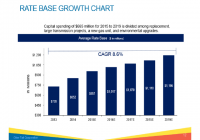Otter Tail Corporation: Reaffirmed Guidance Leading To Next Dividend Bump
Otter Tail Corporation reported 2015 third quarter earnings on November 2, 2015. Guidance for the full year was reaffirmed. Recent events introduce both support and uncertainty for Otter Tail’s near-term future earnings. Otter Tail’s dividend growth history points to another increase in February 2016. Otter Tail Corporation (NASDAQ: OTTR ), a diversified electric utility, started the year a tad slow. In the first quarter, the company lowered its full-year guidance. The second quarter brought an unofficial bump in the full-year projections. On November 2nd, the company reported 2015 third quarter earnings and officially confirmed its unofficial guidance bump. Full-year earnings per share is still expected to be in the middle to upper half of the $1.50 to $1.65 range. In other words, EPS for 2015 is expected to be $1.57 to $1.65. The company’s overall target is for the utility segment to deliver 75% to 85% of total earnings while the manufacturing segment delivers 15% to 25%. Like many utility companies, Otter Tail pays an attractive dividend – $1.23 annually. Its strategy is to allocate the utility segment’s earnings in support of the dividend. Its manufacturing segment’s earnings are intended to cover corporate costs and drive share price appreciation. For the third quarter, the utility segment earned $0.34 per share exceeding the dividend payment of $0.3075. The manufacturing segment earned $0.15 per share exceeding the corporate costs of $0.07. Year-to-date, the utility segment has earned $0.91 per share trailing the year-to-date dividends of $0.9225. The manufacturing segment has earned $0.40 which is $0.24 ahead of corporate costs of $0.16. Third quarter results revealed both support and uncertainty for full-year projections and Otter Tail’s near-term future. In support of its long-term goals, on September 1st, Otter Tail acquired Impulse Manufacturing. Impulse is located in Dawsonville, Georgia. The metal fabricator will join Otter Tail’s BTD Manufacturing segment. The acquisition is expected to be accretive to earnings in 2016. In 2014, Impulse generated $27 million in revenue compared to BTD’s $219.6 million. On August 3rd, the EPA (Environmental Protection Agency) published its final Clean Power Plan. The fully-implemented plan is designed to reduce carbon dioxide in machines from power plants by 30% of 2005 levels. Otter Tail believes the final Section 111(d) rule was a major change from the proposed rule. Its initial analysis showed the impacts to Otter Tail were improved under the final rule as compared to the proposed rule. Compliance begins in 2022 and must be complete before 2030. States must submit plans for approval by September 2016 and must receive approval by September 2018. Otter Tail is working with South Dakota, North Dakota and Minnesota to determine a framework and plan for each state’s compliance. At this point, Otter Tail is encouraged regarding its plant in South Dakota, concerned regarding the required addition of renewable energy in North Dakota and expecting its planned retirement of a plant in Minnesota to aid in compliance. Overall, the company expects the legislation to create increases in the costs of generation for its customers. Regarding renewable energy, the plan establishes eligibility dates: “Incremental emission reduction measures, such as RE and demand-side EE, can be recognized as part of state plans, but only for the emission reductions they provide during a plan performance period. Specifically, this means that measures installed in any year after 2012 are considered eligible measures under this final rule, but only the quantified and verified MWh of electricity generation or electricity savings that they produce in 2022 and future years, may be applied toward adjusting a CO2 emission rate.” In North Dakota, Otter Tail expects the state to have to add a substantial amount of wind power. In 2013, South Dakota was producing more than 25% of its electricity from wind. Minnesota will require 25% of its electricity to be generated from wind by 2025. Finally, Otter Tail’s third quarter information mentions a potential impact to earnings before year-end. “Should the federal government change current tax law before the end of 2015, the corporation’s consolidated earnings guidance could be negatively impacted in the range of $0.02 to $0.04 per share.” Considering there are $0.08 in the range of $1.57 to $1.65, the potential negative impact could be absorbed and Otter Tail would still meet its own projections. The company has earned $1.15 per share in the first nine months of 2015. Therefore, Otter Tail’s fourth quarter must deliver $0.42 to $0.50 in EPS. Since Otter Tail is a “winter-peaking” utility, achieving full-year guidance should not be a problem. The company’s dividend yield is healthier than other diversified utility companies. With full-year guidance reaffirmed, the stability of Otter Tail’s dividend is also presumed. Prior to 2009, the company increased its dividend for 33 consecutive years. In February of both 2014 and 2015, Otter Tail reestablished the tradition. February, 2016 should yield yet another increase.
